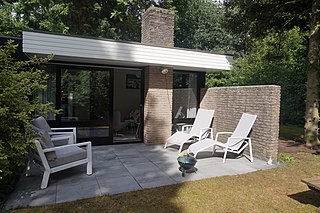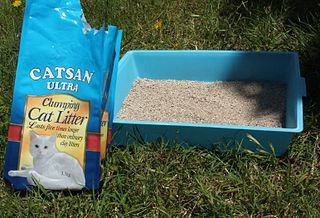
A patio is an outdoor space generally used for dining or recreation that adjoins a structure and is typically paved. In Australia the term is expanded to include roofed structures such as a veranda, which provides protection from sun and rain. Pronunciation can vary in Australia as well: patty-oh is perhaps more common generally although payshee-oh may be used by older Australians.
Trap–neuter–return (TNR), also known as trap–neuter–release, is a controversial method that attempts to manage populations of feral cats. The process involves live-trapping the cats, having them neutered, ear-tipped for identification, and, if possible, vaccinated, then releasing them back into the outdoors. If the location is deemed unsafe or otherwise inappropriate, the cats may be relocated to other appropriate areas. Ideally, friendly adults and kittens young enough to be easily socialized are retained and placed for adoption. Feral cats cannot be socialized, shun most human interaction and do not fare well in confinement, so they are not retained. Cats suffering from severe medical problems such as terminal, contagious, or untreatable illnesses or injuries are often euthanized.

A litter box, also known as a sandbox, cat box, litter tray, cat pan, potty, pot or litter pan, is an indoor feces and urine collection box for cats, as well as rabbits, ferrets, miniature pigs, small dogs, and other pets that instinctively or through training will make use of such a repository. They are provided for pets that are permitted free roam of a home but who cannot or do not always go outside to excrete their metabolic waste.

Housebreaking or house-training is the process of training a domesticated animal that lives with its human owners in a house or other residence to excrete outdoors, or in a designated indoor area, rather than to follow its instinctive behaviour randomly inside the house.

A feral cat or a stray cat is an unowned domestic cat that lives outdoors and avoids human contact: it does not allow itself to be handled or touched, and usually remains hidden from humans. Feral cats may breed over dozens of generations and become an aggressive local apex predator in urban, savannah and bushland environments. Some feral cats may become more comfortable with people who regularly feed them, but even with long-term attempts at socialization, they usually remain aloof and are most active after dusk. Of the 700 million cats in the world, 480 million of them are feral.

A sty or pigsty is a small-scale outdoor enclosure for raising domestic pigs as livestock. It is sometimes referred to as a hog pen, hog parlor, pigpen, pig parlor, or pig-cote, although pig pen may refer to pens confining pigs that are kept as pets as well. Pigsties are generally fenced areas of bare dirt and/or mud. "Sty" and "pigsty" are used as derogatory descriptions of dirty, messy areas, the word sty deriving from the Proto-German stijan meaning filthy hovel. There are three contributing reasons that pigs, generally clean animals, create such a living environment:

A luxating patella, sometimes called a trick knee, is a condition in which the patella, or kneecap, dislocates or moves out of its normal location. It can be associated with damage to the anterior cruciate ligament.

The Memphis Zoo is a zoo in Midtown, Memphis, Tennessee, United States. It is home to more than 3,500 animals representing over 500 different species. Created in April 1906, the zoo has been a major tenant of Overton Park for more than 100 years. The land currently designated to the Memphis Zoo was defined by the Overton Park master plan in 1888, it is owned by the City of Memphis. The zoo is set on 76 acres (31 ha), of which approximately 55 acres (22 ha) are developed.

Free range denotes a method of farming husbandry where the animals, for at least part of the day, can roam freely outdoors, rather than being confined in an enclosure for 24 hours each day. On many farms, the outdoors ranging area is fenced, thereby technically making this an enclosure, however, free range systems usually offer the opportunity for the extensive locomotion and sunlight that is otherwise prevented by indoor housing systems. Free range may apply to meat, eggs or dairy farming.

Onychectomy, popularly known as declawing, is an operation to remove an animal's claws surgically by means of the amputation of all or part of the distal phalanges, or end bones, of the animal's toes. Because the claw develops from germinal tissue within the third phalanx, amputation of the bone is necessary to fully remove the claw. The terms onychectomy and declawing imply mere claw removal, but a more appropriate description would be phalangectomy, excision of toe bone.

A semi-feral animal lives predominantly in a feral state but has some contact and experience with humans. This may be because it was born in a domesticated state and then reverted to life in wild conditions, or it may be an animal that grew up in essentially wild conditions but has developed a comfort level with humans through feeding, receiving medical care, or similar contacts.

Creme Puff was a mixed Tabby domestic cat, owned by Jake Perry of Austin, Texas, US. She was the oldest cat ever recorded, according to the 2010 edition of Guinness World Records, when she died aged 38 years and 3 days.

–
Aging in cats is the process by which cats change over the course of their natural lifespans. The average lifespan of a domestic cat may range from 10 to 13 years. As cats senesce, they undergo predictable changes in health and behavior. Dental disease and loss of olfaction are common as cats age, affecting eating habits. Arthritis and sarcopenia are also common in older cats. How a cat's health is affected by aging may be managed through modifications in a cat's diet, accessibility adjustments, and cognitive stimulation.
Cat behavior is a cat's behavior and responses to events and other stimuli. Cat behavior includes body language, elimination habits, aggression, play, communication, hunting, grooming, urine marking, and face rubbing. It varies among individuals, colonies, and breeds.
Feline vaccination is animal vaccination applied to cats. Vaccination plays a vital role in protecting cats from infectious diseases, some of which are potentially fatal. They can be exposed to these diseases from their environment, other pets, or even humans.
Feline idiopathic cystitis (FIC) or feline interstitial cystitis or cystitis in cats, is one of the most frequently observed forms of feline lower urinary tract disease (FLUTD). Feline cystitis means "inflammation of the bladder in cats". The term idiopathic means unknown cause; however, certain behaviours have been known to aggravate the illness once it has been initiated. It can affect both males and females of any breed of cat. It is more commonly found in female cats; however, when males do exhibit cystitis, it is usually more dangerous.

Cat training is the process of modifying a domestic cat's behavior for entertainment or companionship purposes. Training is commonly used to reduce unwanted or problematic behaviors in domestic cats, to enhance interactions between humans and pet cats, and to allow them to coexist comfortably. There are various methods for training cats which employ different balances between reward and punishment.
A pet exotic felid, also called pet wild cat or pet non-domestic cat, is a member of the family Felidae kept as an exotic pet.
Pet culture refers to the culture revolving around the interaction of humans and pets.














